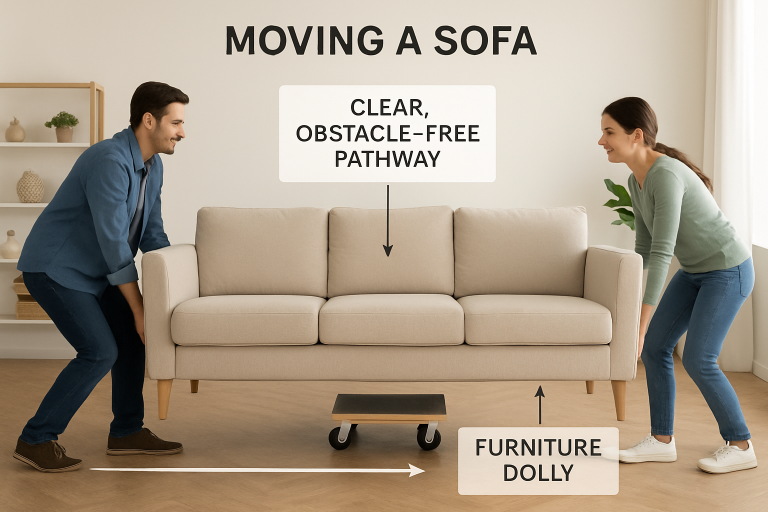Moving heavy furniture may seem impossible at first, but with proper planning and the right techniques, you can protect both your health and your home. Whether you’re shifting a massive sofa or an old wardrobe, following expert tips on heavy furniture moving can help you achieve a stress-free experience. Taking time to evaluate your environment, gather necessary tools, and use proper methods reduces the risks of accidents, strains, and property damage. Ensuring a safe move isn’t just about muscle; it’s about preparation and understanding how to handle bulky objects. Knowing how to plan ahead and organize your helpers can make all the difference. Before you get started, consider whether your furniture will fit through your home’s tight spaces or if you’ll need to disassemble it first. Assessing these factors and establishing a clear pathway keeps the process smooth.
If you need to move unexpectedly or have little time to prepare, it’s essential to stay organized and avoid rushing the task. Unplanned moves present greater risks, so a safety-first approach is essential. Reviewing proven tips from moving experts and reliable sources can help ensure you’re ready for anything. Safety, efficiency, and teamwork are your best allies in a successful heavy furniture relocation.
Plan Ahead
Before you attempt to lift or move anything, even during a last-minute moving scenario, assess your space and measure your furniture, doorways, hallways, and staircases. This helps you anticipate tight corners or potential hazards, preventing costly dents, dings, or personal injury. Clear pathways by removing rugs, cords, shoes, and any other tripping hazards. Planning each step ensures your move proceeds without unnecessary interruptions or surprises. For multi-floor homes, planning should also include mapping the safest route to your destination room, considering the easiest angles for turning large items. If possible, take photos or notes as you measure to help you remember trouble spots. Even in last minute moving situations, simple planning saves time and potential headaches later on.
Being prepared, even at the last minute, reduces stress and keeps everyone safe. A few extra minutes spent organizing now can prevent hours of frustration during the move.

Gather Necessary Tools
To move heavy furniture safely, you’ll need more than just your hands. Essential moving supplies can make a big difference:
- Furniture Sliders: These let you glide couches, dressers, and beds across hard floors or carpeted rooms, reducing physical effort and minimizing floor damage. Choose felt sliders for hard surfaces and plastic for carpets.
- Moving Straps: Products like shoulder dollies distribute weight more evenly, letting you leverage your legs and core instead of your back. This is particularly helpful for tall or bulky pieces.
- Furniture Dollies: Sturdy, wheeled platforms for rolling heavy furniture through hallways and rooms efficiently and safely. Always secure the load with straps or bungee cords to prevent accidents.
Use Proper Lifting Techniques
The way you lift matters more than how strong you are. Improper lifting is a leading cause of back injuries, so always:
- Lift with Your Legs: Do not bend at the waist. Keep your back straight, squat, and press upward with your legs.
- Keep the Load Close: Holding items close to your core reduces strain on your back.
- Avoid Twisting: Turn your whole body with your feet rather than twisting your torso, which can easily lead to pulled muscles or worse injuries.
Disassemble Furniture
If possible, break down large or awkward furniture into manageable pieces. Remove legs, cushions, drawers, doors, and detachable arms to reduce bulk and weight. Not only does this make lifting easier, but it also protects your furniture and home from accidental scrapes. Store hardware, such as screws and bolts, in labeled plastic bags or small containers so you don’t lose anything during the process. According to U.S. News & World Report, planning and disassembling furniture carefully are key steps to ensure a smoother long-distance move. Refer to your furniture’s manual for guidance or search online for manufacturer instructions if you’re stuck. Many everyday items have online tutorials for safe disassembly.
Protect Your Home
- Shield Floors: Use moving blankets, towels, or specialized pads on hardwood, tile, or laminate to prevent scratches and dents.
- Padded Protection: Wrap door frames, railings, and banisters with towels or foam padding to prevent scuffs and chips.
- Use Ramps or Boards: For moving up or down stairs, a sturdy board or moving ramp can ease transitions and minimize impact and bouncing that can lead to dropping items and injuries.
Enlist Help
Moving heavy furniture solo is never recommended. Ask friends, family, or neighbors for help. Designate roles for each person, and always communicate clearly. Practice lifting and moving together briefly before the big move, so everyone understands their responsibilities and can move as a team.
Team Coordination Tips
- Count down before lifting or setting down furniture.
- Assign a leader to call out instructions and identify hazards.
- Move slowly and steadily, never rushing or making sudden moves.
Take Breaks
Heavy lifting is taxing. Frequent breaks help you avoid fatigue, when most mistakes happen. Use downtime to hydrate, stretch, and plan the next step. Pushing yourself too hard can result in personal injury or property damage, so work steadily but don’t rush.
Consider Professional Movers
If your furniture is especially valuable or significant, or if the task feels overwhelming, consider hiring professional movers. Professionals have the expertise and specialized equipment to ensure everything stays safe and undamaged. The investment in their services can save you money in the long run by preventing injuries and costly repairs.
For complex moves or when you’re under extreme time pressure, even a short consultation with pros can be invaluable, providing guidance and reducing your stress as you complete your move.
By incorporating each of these steps, you’ll protect yourself, your furniture, and your home, ensuring your heavy furniture moves as smoothly as possible.



